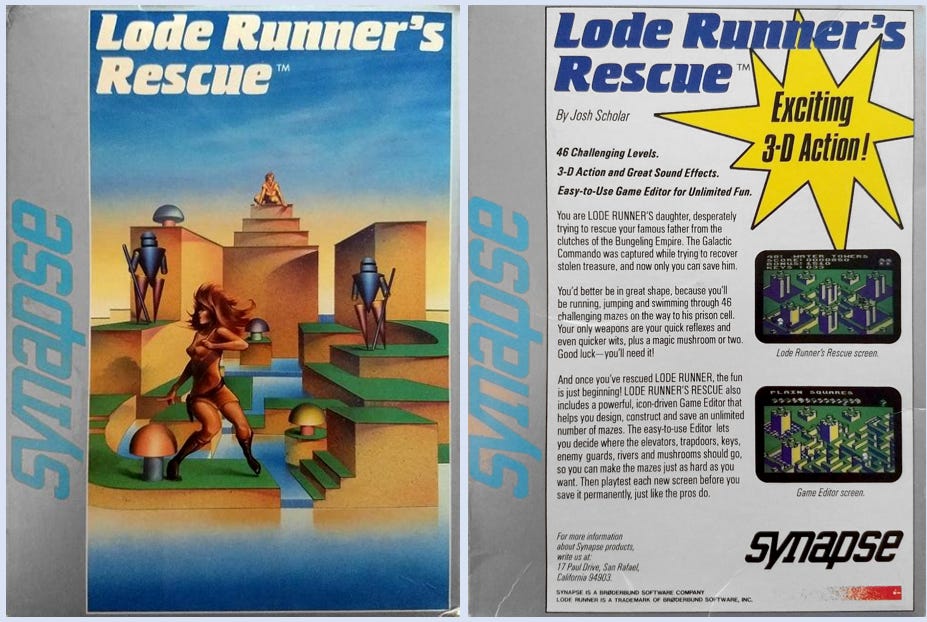The Classic PC Gaming Era (1977-1989) - Lode Runner’s Rescue
Don't miss this odd but interesting isometric rescue game that is nothing like its namesake but rather plays like an ancestor of Monument Valley.

RELEASE DATE: 1985
DEVELOPER / PUBLISHER: Synapse Software
PLAYABILITY TODAY: Somewhat playable
BEST VERSIONS: Commodore 64
Doug Smith’s 1983 platform puzzler Lode Runner was a tremendously popular and important title for PC gaming which not only eventually stretched across many platforms (including coin-op cabinets), but was a true global hit, influencing game development in North America, Europe and Japan. Much like the 1980 arcade game Space Panic, the protagonist had limited capabilities to evade or trap the Bungeling Empire’s robotic guards while collecting treasure, and many of the game’s 150 maps required actual strategy to complete. But Lode Runner also provided players with a level editor to create maps of their own and it was one of the first games where fans could actively create their own maps and share them with others; Computer Gaming World even held a competition where users could submit levels to potentially be included on a compilation disk.

As Lode Runner’s popularity grew, publisher Brøderbund released Championship Lode Runner in 1984 with 50 levels intended for experts only. Overseas, Irem created four Japan-only arcade adaptations from 1984 to 1986 with new levels and prettier graphics while Compile created a Sony-published Japan-only Lode Runner II for the MSX in 1985 which looked exactly like the original but had many new levels. The Famicom and MSX even got a game titled Super Lode Runner which adapted the arcade experience for home players.
But Lode Runner also received a sequel in the North American market by Josh Scholar called Lode Runner’s Rescue, an odd title by that was published through Synapse Software, a company that had been producing games on its own before Brøderbund Software acquired them in 1984 and temporarily used their label as an imprint. The sequel bore little resemblance to the original game, eschewing the original flat platforming for a 3D isometric style and replacing the treasure with keys. As a Lode Runner game, it’s a disappointing follow-up, and it’s been common conjecture that it was originally designed to be a standalone title but was shoehorned into the popular series by Brøderbund to boost sales. (The fact that the graphics seem to be themed around Alice’s Adventures in Wonderland is an obvious indication of the game’s original design.)
But as a standalone title or a spin-off, Lode Runner’s Rescue is still a decent game on its own, using its isometric perspective similar to Atari’s Crystal Castles to create some levels that are not only graphically interesting, but also challenging to complete. Many of the levels take on an M.C. Escher sort of aesthetic, and understanding how to navigate the varied heights of blocks, the back sides of walls and the direction in which water flows in rivers, lakes and streams is key to completing the game. While Lode Runner is as much about timing as it is about reflexes, Lode Runner’s Rescue is much more heavily focused on understanding how to puzzle through its labyrinths and figuring out how the guards can be tricked, avoided or jumped over in order to collect all of the keys on a stage.
It’s also a challenging game; the 46 included stages start out hard and get much harder as things progress. It takes time to get used to the controls, which force the player to move diagonally to suit the perspective, and deaths are fairly frequent. Many levels have a cat the character can pick up for extra lives, but the kitty’s so skittish that it can be hard to reliably catch The good news is that unlike a lot of games from the mid-80s, players are given the opportunity to start from the level where they ran out of lives rather than having to go all the way back to the beginning, which at least helps the game not to become a frustrating exercise in rote memorization through extensive trial and error. The final level is extremely tough and the rescue of your “father,” the original Lode Runner, is sadly anticlimactic. Fortunately, like the original Lode Runner, there’s also a level editor for those who simply can’t get enough after that.

While the Atari 8-bit PC did receive a version of Lode Runner’s Rescue, the Commodore 64’s version far surpasses it in graphical quality and overall playability. Critics gave this game a decent score back in the day, but it wasn’t nearly as big a hit as Lode Runner and Brøderbund soon shut the Synapse Software imprint down entirely before itself becoming part of a string of acquisitions that would eventually shutter it as well. Outside of Japan, Lode Runner never received a true sequel in the style of the original game, and the series has sadly languished despite several attempts by different developers to bring it back; the best have probably been the Xbox 360’s Lode Runner (2009) and the 2017 Lode Runner: Legacy on the PC, PS4 and Switch.
As Our Series Continues…
In the coming weeks, we’ll wind down our look at the classic PC era as we talk about puzzle games and unusual games before we begin delving into the arcade and console games you missed from the 1980s.
If you’ve missed the earlier entries in the series, which cover ASCII games, adventure games, wargames, strategy games, role-playing games, sports games, fighting games, brawlers and more, you can find the entire archive at https://greatestgames.substack.com.
Anything I don’t share here will be in my upcoming book, tentatively titled The Greatest Games You (Probably) Never Played Vol. 1. Subscribe to this newsletter so you won’t miss it!



